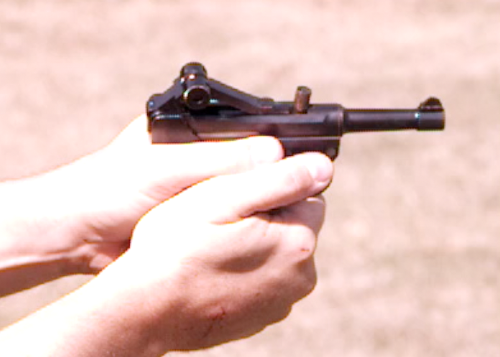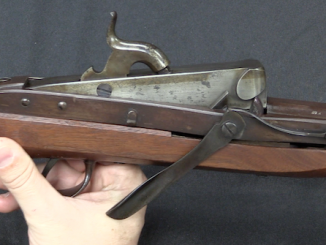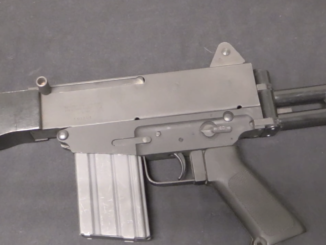The General Liu rifle (named for its designer – it never received an official designation that we know of) was China’s closest approach to an indigenous self-loading infantry rifle before World War II. Mechanically it used the same principles as the Danish Bang rifle – a muzzle cup captured some of the gases from firing and was pulled forward, moving a cam and lever that cycled the bolt. Liu was appointed head of the Hanyang Arsenal, and used the opportunity to put a new semiautomatic rifle into production.
The Pratt & Whitney company of Hartford was contracted to supply the machinery to mass-produce the rifle, and about a dozen sample rifles were built by P&W. They were tested in China and met with general approval, and the machinery was loaded up and shipped to Shanghai. Unfortunately, General Liu suffered a stroke and either died or was incapacitated (sources differ on this) before the tooling arrived, and it ended up sitting on the docks for years, as the rifle project foundered and never cam to fruition without Liu’s supervision. The tools were eventually sent to an arsenal and repurposed for producing other guns.




Really outstanding and fascinating! Thanks!
I’ve long been interested in the Søren Bang system, and not much out there about the Gen. Liu rifle apart from photos.
8x57mm? .30-06? I seem to recall that at least some Bang prototypes were 7mm?
Laughing with ya, not at ya Ian, but you really might consider an “out-takes” for us… I can imagine what happens when you go off camera and then resume the video with an airy “you can see that the pin has to be a very tight fit because the front sights of the rifle sit here on the forward end cap…” Ha! Cheers!
The auction link states that it’s a 7.9 x 57, which being intended for Chinese service shouldn’t surprise anybody.
The bolt system seems more like that of the Italian Cei-Rigotti than the Bang, with that bolt track extending aft. Although the bolt cover assembly is closer to a Ljungman, with a bolt retractor more like the later Egyptian Rashid version.
I’d think it would be difficult to get a proper cheek-weld without the end of that bolt track poking you in the nose.
cheers
eon
Thanks eon! I should have consulted the link more closely/less superficially!
I agree that while the firer might well blink during full recoil and miss it, the entire bolt/carrier/receiver assembly coming backward–however instantaneously–would be disconcerting. And if it ever did contact a protruding nose, well, Ouch!
Also, wouldn’t it push a jet of rain water, mud, debris into the firer’s face in, erm, “less than ideal conditions?”
I’d imagine that was a selling point. Mud and etc. being thrown “out” wouldn’t be stuck in the mechanism.
The major thing I wonder about is how much parts failure is necessary for the bolt to remove itself in firing? As in a “Ross”-type “removal”.
Yeee-OWTCH!!
cheers
eon
An interesting “what might have been” and how China (albeit with US help/technology transfer) came very close to adopt a reasonably functional semiauto rifle before advanced industrialised Western nations. Thanks Ian!
“interesting “what might have been” and how China (albeit with US help/technology transfer) came very close to adopt a reasonably functional semiauto rifle before advanced industrialised Western nations”
I am not sure whatever it would be working well in field service.
Gas-trap seen to never be good solution and were sooner ot later abandoned.
I am not expert on 1920s weather in China, but if I am not mistaken, there was wide weather spectrum there and environment type: humid might be encountered (never friendly to weapons).
I am not expert on Chinese 1920s Army so I will ask: were their soldiers ready to self-loading rifle?
In addition to humid also extremely cold in Inner Mongolia province. This reality probably effects Chinese small arms in general.
I’m pretty sure that the overall conditions against a Chinese self-loading rifle included a shortage of interested Chinese intellectuals/firearms experts (thanks a lot, Qing Dynasty), a shortage of dedicated resources (money, refined steel, and tooling), and constant turmoil due to backstabbing warlords…
Did I mess up?
Nope. China back then was basically a gaggle of semi-autonomous satrapies flying in close formation.
For some useful data on how things were, albeit in fiction, read The Sand Pebbles by Richard McKenna (who based it on his time on China Station in the U.S. Navy) and pretty much anything by Pearl S. Buck.
For non-fiction, read Stilwell and the American Experience in China 1911-45 by Barbara W. Tuchman.
It’s ironic that China, where steel was first refined and the “Siemens” steel process was invented (in the 5th Century AD!) had by the 20th Century come to the state it was in in metallurgy. Simply put, there really wasn’t any “good” steel made there. Which does not help in arms making.
For an eye-opener as to what China first created (before pretty much anybody else) see The Genius of China; 3,000 Years of Science, Discovery, and Invention by Robert F.Temple.
cheers
eon
“I am not expert on 1920s weather in China, but if I am not mistaken, there was wide weather spectrum there”
It’s often said that of all the countries in the world, China has the most similar climate overall to the United States (and if you’re a gardener, you’re probably aware of that — for both good and bad).
Well, Daweo, that is why I wrote “reasonably functional semiauto” and only that; I guess the Liu rifle was intended to be distributed to selected riflemen and not a general service weapon. And yes, I fully agree that the gas-trap solution was indeed doomed in the short-term.
Had this on full30:
Nice Flag Ian. As for the translation:陸軍漢陽兵工廠製. 陸軍=Army 漢陽=Hanyang(Hanyang District) 兵工=ordanance 廠製= factory system. (I’am not sure how to best translate these last two for the gas system) 自= oneself, certainly, from. 普=general, like generally.
Super effort- much appreciate it.
I think
兵工廠 = military ordnance factory
製 = production
and
自 = auto
普 = normal
Finally I was able to see Liu’s rifle up close – thank you!
While operating mechanism is certainly intriguing, what gets me (as usually is the case) is level om finishes and overall precision – it’s gorgeous. This is not what I would (with degree of residual prejudice) not expect from Chines product of the period.
But yes, I recognize this was likely made by Pratt&Witney.
Btw, I recall having seen P&W label on machine tools delivered to Europe after end of WWII. They were very solid build and easy to maintain/repair. Lots of ‘spare material’ on them.
Mannlicher style bolt comes from the Kuaili rifle (based largely on 1888 Mannlicher) which the Chinese were familiar with from their 1st indigenous rifle design effort. On strength of bolt locking wedge pin, does the BAR not have same basic limitations ?
Also Pratt and Whitney mentioned in video is the machine tool manufacturer below, not the (much better known today) aero engine company that was started post WWI by ex-Curtis Wright employees which “licensed” the Pratt Whitney name
https://en.wikipedia.org/wiki/Pratt_%26_Whitney_Measurement_Systems
A great review about a definitely forgotten rifle. Has a slight typo, “…never cam to…” just thought I’d point that out.
I seem to remember reading somewhere about a 6.8mm/.270-caliber cartridge based on either the 7mm or 8mm Mauser round being in the development history of this rifle. Anybody else remember anything like that? If so, it would of been well ahead of Winchester’s development of their .270 cartridge.
“6.8mm/.270-caliber cartridge”
There was 6.8×57 Mauser cartridge, see municion:
http://www.municion.org/Dwm/Dwm511A.htm
maybe someone knowing Español will be able to translate that short text, but anyway I can see that: Mauser Modelo 1907 appear here so it was probably developed around 1907 and following examples are shown:
1 made by DWM (Karslruhe, Germany)
1 made by GR (Austria)
so I presume it was developed in Germany XOR Austria.
It claims that “China [who?] adopted a 1907 Mauser rifle in 6.8x57mm caliber.
Production of rifles in the caliber had not been completed, let alone shipment to China when the First World War broke out in 1914. The stock was seized for use by the German army [like the M1912 Chilean/Colombian/Mexican 7mm Mausers by the Austro-Hungarian K.u.K.], re-barreled to 7.92x57mm J, and used by Würtemburg infantry regiments.
Another fabricator of the ammunition, Austrian George Roth used the denomination 6.8×56.3mm. It was manufactured in China proper, at least until 1917, when the project was abandoned in favor of all 7.92x57mm J cartridge production.
A parallel development of a Model 1908 6.8x60mm Mauser cartridge was never formally adopted by China.
It is a very scarce cartridge; few examples of it are known.”
For similar service cartridge, see 6.5×58 Mauser Vergueiro (default rifle cartridge of Portugal):
http://www.municion.org/6_5x58P/6_5x58P.htm
Service cartridge of Portugal from 1904-1937, when it was replaced by 7.92x57mm Mauser during the Sálazar “Estado Novo” or New State authoritarian period/regime. In WWI, the Portuguese CEP used 7,7/•303-in. SMLEs, Lewis Guns, Vickers, etc., hence m/917 nomenclature. Some Mauser Vergueiro rifles and ammunition, alongside the Kropotscheks it was designed to replace, were used in Africa. During the Estado Novo period, some 40k were converted to 7.92mm at Braço de Prata.
The Mauser Vergueiro uses a split receiver bridge and has some Mannlicher design elements.
That’s correct: the Portuguese used the Mauser-Vergueiro m/904 in its proprietary 6.5×58 cartridge in the African fronts in WWI, alongside Maxim mgs in the same chambering. The Mauser-Vergueiros converted to 7.92mm at Braço de Prata arsenal were designated Mauser m/904/39.
Chinese sources, with no citing, stated that General Liu’s ship with the tooling actually sank on its way to China, circa 1918 or 1919, and his son was onboard along with many of his staff and perished. Liu lost power to the various warlords in 1920, and was also ill and retired in 1920. The sunken machinery was recovered in 1919 and delivered to Shanghai, where it sat for 2 years, and finally handed to a different ordnance factory, and it wasn’t until 1939 when the machinery was finally moved to Hangyang Arsenal. Liu himself died in 1929, at the age of 60.
https://kknews.cc/history/y65rl3k.html
However, the story about the ship sinking was not repeated anywhere else and cannot be corroborated.
A different article claimed that General Liu was inspired by the Danish M1922, and did not mention ship sinking.
Yet another article claimed that General Liu studied in Japan and majored in armaments design.
Several Chinese articles claimed that Springfield Armory Museum kept the copy General Liu sent them for test trials.
Anyone else knows this one because of BF1?!